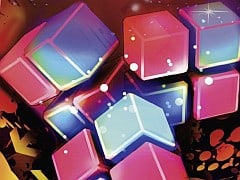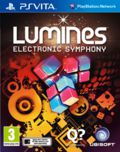You can trust VideoGamer. Our team of gaming experts spend hours testing and reviewing the latest games, to ensure you're reading the most comprehensive guide possible. Rest assured, all imagery and advice is unique and original. Check out how we test and review games here
“Haemorrhoids?” I ask Andy, VideoGamer.com sales executive and trivia taskmaster. I’m not sure what he’s talking about, but it’s definitely got something to do with my bum. I close my eyes and see Lumines: Electronic Symphony’s neon-lit squares tessellating themselves into perfect oblivion. Aah, that’s better.
It’s all about your anal cushions, apparently, and I know this because I’m in a discussion about how sitting on the toilet for too long is actually bad for your health. Esquire has the science answer: “sitting on the toilet too long can increase pressure on these anal cushions, which may eventually cause them to become haemorrhoids.”
So, basically, Lumines: Electronic Symphony is probably going to give me haemorrhoids, because every time I’ve nipped off for a twosie in the past week I’ve ended up plopping time into the game. I appreciate it Ubisoft, thanks a bunch Q Entertainment. At least this passes the first test of any good time-gobbling puzzler, and that’s the fact that it eats away at your life whenever it can.
In all honesty I was supposed to have this review done a few days ago, but I was so involved in a game of Lumines (I finished on a somewhat pathetic score of 615,558) I was completely loathe to quit back to the main menu and test some of the game’s other features out.
Lumines: Electronic Symphony also passes the second test, which is that it’s packed with enough whizz-bang (thanks, mostly, to the soundtrack) to push you, time and time again, past the dry early minutes into the more satisfying middle-game – the bit when a puzzler becomes puzzling, if you will. The core idea is in filtering combinations of dual coloured, two-by-two blocks into single-coloured quadrilaterals (bigger is better) before a scrolling line, moving in time with the beat of the music, whizzes them off the grid in exchange for some juicy points. It’s as entertaining as ever.
For the most part, though, it’s a bit on the easy side. Form enough blocks, or wait out a timer, and the game’s aesthetic – backing music, block colours and backgrounds, dubbed a ‘skin’ in-game – ticks to the next one in the sequence. The game’s primary mode, Voyage, takes about an hour of play before it starts to become perplexing, and while an ultra-difficult Master Mode is available it would have been nice to be able to more easily and immediately play in that middle-ground between remedial and genius.
It works, though, because it’s really chuffing hypnotic. Lumines’ symbiotic relationship with music means the tracklisting has to work, which is where 2006’s scattered Lumines II so completely dropped the ball – the pursuit of big Western artists caused the game to lose the original’s perfectly pitched combination of rhythm and pace. Electronic Symphony presents an altogether more considered (and decidedly European) 30-strong selection, and includes headline artists such as The Chemical Brothers, Aphex Twin and The Go! Team. It’s a real shame that Q! Entertainment’s much-loved Genki Rockets don’t make an appearance, though, and that there’s no scope to showcase some of the more eclectic Japanese artists in this otherwise excellent curation.
Lumines also manages to provide something so many puzzle games lack: a noticeable sense of progression. Clearing each skin feels like progress, and the side-effect of such a wildly changing player space is that a session of Lumines feels like a journey, albeit one that might progress from Mylo’s In My Arms to Wolfgang Gartner’s remix of 5th Symphony, and then finishes on Faithless’ God is a DJ. But, hey, whatever works for you.
The Vita’s detail-rich OLED screen also ensures the game’s aesthetics pop and sizzle when in play. In motion the game is a beautiful march of colour and sound, and there’s a little thrill in the moment you see each skin for the first time.
It’s still the same game as it was half a decade ago, but the all-important focus on aesthetic means that the new sights and sounds helps refresh the formula. Q Entertainment has also attempted a more direct approach at innovation, giving the game’s user-selectable avatar its own rechargeable power (such as dropping a chain block) that’s accessible after filling a meter by clearing blocks or tapping the back screen. It doesn’t really work.
Other additions fare better. A new shuffle block will randomise any cluster of squares it comes into contact with, though it seems to help more than it hinders. There’s also a social addition in the form of the World Block, a massive regenerating clump that’s whittled down by subtracting the combined cleared blocks of every player in the world within a 24-hour period. You can also gift unlocked avatars via Near, but it’s particularly hard to actually care much about that.
So, yes, it’s another Lumines. But it’s also the most successful crack at the whip since the original game, and for the first time in a long time the soundtrack feels like it’s been properly mulled over. While it’s clear Q Entertainment perfected the game’s formula on their very first try, this iteration of the neon-lit puzzler is so charming and elegantly formed you’d be a fool to say no.
Version Tested: PlayStation Vita

/https://oimg.videogamer.com/images/3c57/lumines_1-109406.jpg)






